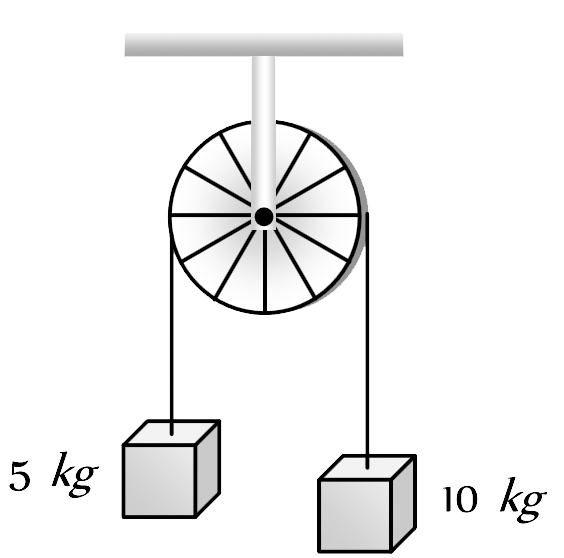A particle moves in the x−y plane under the action of a force →F such that the value of its linear momentum →P at any time tisPx=2cost,Py=2sint.
The angle θ between vecF and vecPatagiventimet will be:Solution in Gujrati
Momentum of the body →P=2costˆi+2sintˆj
So force on the body is →F=d→pdt=−2sintˆi2costˆj
If angle between →F and becp is θ then
cosθ=→F.→pFp=−4costsint+4costsintFp=0 so θ=90∘
Topper's Solved these Questions
- NEWTONS LAWS OF MOTIONBOOK - ALLEN CHAPTER - NEWTONS LAWS OF MOTIONEXERCISE - EXERCISE-I
52 Videos
- NEWTONS LAWS OF MOTIONBOOK - ALLEN CHAPTER - NEWTONS LAWS OF MOTIONEXERCISE - EXERCISE-II
112 Videos
- NEWTONS LAWS OF MOTIONBOOK - ALLEN CHAPTER - NEWTONS LAWS OF MOTIONEXERCISE - EXERCISE-III
28 Videos
- NEWTON'S LAWS OF MOTION & FRICTIONBOOK - ALLEN CHAPTER - NEWTON'S LAWS OF MOTION & FRICTIONEXERCISE - EXERCISE (JA)
4 Videos
- RACEBOOK - ALLEN CHAPTER - RACEEXERCISE - Basic Maths (Wave Motion & Dopplers Effect) (Stationary waves & doppler effect, beats)
25 Videos
Similar Questions
USS 150) Two masses of 5 kg and 10 kg are connected to a pulley as shown. What will be the acceleration of the system (g= acceleration due to gravity)

View SolutionA particle is in straight line motion with uniform velocity A force is not required
View SolutionAssertion: The driver in a vechicle moving with a constant speed on a straight road is in a non-inertial frame of referance.
Reason: A reference frame in which Newton's laws of motion are applicable is non-inertial.
View SolutionA piece of wire is bent in the shape of a parabola y=kx2 (y-axis vertical) with a bead of mass m on it. The bead can slide on the wire without friction. It stays at the lowest point of the parabola when the wire is at rest. The wire is now accelerated parallel to the x-axis with a constant acceleration a. The distance of the new equilibrium position of the bead, where the bead can stay at rest with respect to the wire, from the y-axis is:
View SolutionThe frequency of a radar is 780 MHz. After getting reflected from an approaching aeroplane, the apparent frequency is more than the actual frequency by 2.6 kHz. The aeroplane has a speed of
View SolutionA particle moves in the x-y plane under the action of a force vecF such that the value of its linear momentum vecP at any time t is P_(x)=2 cost and p_(y)=2sint . What is the angle theta between vecF and P at a given time t?
View Solutionएक कण X-Y-तल में एक ऐसे बल के प्रभाव में चलता है कि कण का रेखीय संवेग →p(t)=A[ˆicos(kt)−ˆj(sinkt)] है, जहाँ A तथा k अचर है | बल तथा संवेग के बीच का कोण है :
View SolutionA particle moves in the x-y plane under the action of a force →F such that the value of its linear momentum →P at any time t is Px=2 cost and py=2sint. What is the angle θ between →F and P at a given time t?
View SolutionA particle moves in the x-y plane under the action of a force vec(F) such that the components of its linear momentum vec(P) at any time t are p_(x) = cos t and p_(y) = 3 sin t. What is the magnitude of the vector vec(F) ?
View SolutionF particle moves in x-y plane under the action of force →F such that the value of its linear momentum (→p) at any instant t is px=2 cos t and py=2 sin t. The angle θ between →F→P at a given time t will be-
View SolutionA particle moves in the X-Y plane under the influence of a force such that its linear momentum is vecp(t) = A[(wedge)icos (kt) -(wedge) sin (kt)] where A and k are constants. The angle between the force and the momentum is:
View SolutionA particle moves in X-Y plane under the action of forces F such that the values of linear momentum 'p' at any times is px=2cost and py=2sint . The angle between →F and at the time t will be:
View SolutionA particle moves in X-Y plane under the action of forces F such that the values of linear momentum 'p' at any times is px=2cost and py=2sint . The angle between →F and at the time t will be:
View SolutionA particle moves in the X-Y plane under the action of a force →F such that the value of its linear momentum (→P) at any time .t., and its components are PX=2cost,PY=2sint. According to defination of force →F=d→Pdt
The angle .θ. between →Fand→P at a given time .t. will be
View SolutionA particle moves in the xy-plane under the action of a force F such that the components of its linear momentum p at any time t and p_(x)=2cos t, p_(y)=2sin t. the angle between F and p at time l is
View Solution
